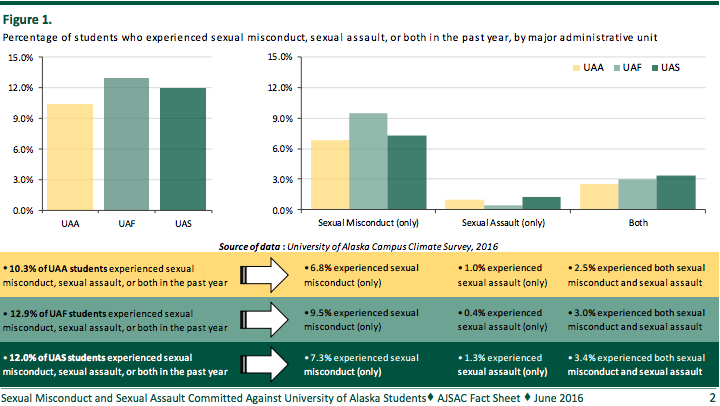Results of a new study looking at the sexual victimization of University of Alaska students has alarmed Saralyn Tabachnick, executive director of Juneau’s AWARE.
“I find the results disturbing. This is 100 percent preventable,” she said.
An estimated 11.4 percent of University of Alaska students — or one out of every nine — experienced sexual misconduct, sexual assault or both in 2015. That’s according to results of a study by the Alaska Justice Statistical Analysis Center at University of Alaska Anchorage released Monday.
For University of Alaska Southeast, that number is slightly higher at one out of every eight students, or an estimated 12 percent of the total undergraduate and graduate student population of 2,364.
While Tabachnick said the results are disturbing, she said they’re also not surprising.
“But wouldn’t it be wonderful to live in a culture where it was a surprise, where violence like this is not the norm?” she asked by phone Monday.
This is the first time the UA system has publicly released such figures.
“These numbers help us go from anecdote to actual data,” said Lindsey Blumenstein Ph.D., assistant professor at the UAA Justice Center, in a phone interview Monday. She led the study. “We just had never looked at a victimization survey of our students.”
University of Alaska campuses are federally required to release crime statistics, which include sex offenses reported to administration. Many instances of sexual assault and misconduct go unreported.
The study’s estimates are based on 1,982 responses to an online student survey conducted between February and March of this year. The survey was designed to establish baseline estimates of sexual misconduct and sexual assault committed — on and off campus — in the preceding year against students enrolled at UA during the 2016 spring semester. Questions were modeled after recommendations by the White House Task Force to Protect Students from Sexual Assault.
Blumenstein said getting baseline estimates is necessary when trying to stop sexual misconduct and assault.
“If you want to evaluate a prevention program and you want to know if it’s working, you have to know what was happening before you put the prevention program in place to see if things went up or down. So these are the first public numbers that we have available about sexual victimization for UA students,” she said.
In the past few years, UAA, University of Alaska Fairbanks and UAS have followed national mandates to improve sexual assault prevention efforts and stay compliant with Title IX, the federal law that protects people from discrimination based on sex or gender and guarantees access to education in institutions that receive federal funding.
“I think that we have to ask the tough questions if we want to be able to make change. We have to be able to ask what’s gong on in order to know where we need to be putting our efforts. And while this is a big problem across the nation, the prevention programs are still in their infancy to a certain extent because this isn’t something we’ve been focused on for that long a period of time,” Blumenstein said.
In the survey, sexual misconduct refers to unwanted, uninvited or coerced sexual touching or sexual commentary. Examples include kissing without permission, grabbing, fondling, taking a sexual experience further than wanted, or lewd comments that make a person feel uncomfortable, uneasy or unsafe. Sexual assault refers to nonconsensual or unwanted sexual contact with penetration.
Of the students statewide who experienced sexual misconduct, sexual assault or both, nearly a third experienced at least one attempted or completed sexual assault. Just looking at UAS, about 110 students were victims of at least one attempted or completed sexual assault.
Blumenstein said the numbers are similar to what other universities and colleges around the nation are finding, but she said the results are likely conservative.
“Even though the survey was done online, there’s still a lot of shame, a lot of stigma, a lot of victim blaming that goes on with victims of sexual violence and it’s very difficult for people to come forward about their experiences,” she said. “I think these number are accurate, but I think they’re conservative. I think it’s possible they could be a little higher.”
UAS Title IX coordinator Lori Klein was out of the office and could not be reached for comment.
[How UAS handles sex assault complaints on campus is changing.]
The UAA Alaska Justice Center plans on releasing more data from the survey in the coming months. Blumenstein is positive the UA branches will utilize the numbers to affect change, and she hopes UA students and the community as a whole will do the same.
“We want a holistic community approach. We want to be working from all angles and have community-wide resources and prevention to help deal with this issue,” she said.
AWARE’s Saralyn Tabachnick agreed.
“Now we have these results and they’re being shared. Ideally, people are becoming more aware and awareness can lead to a greater change,” she said.
AWARE already works closely with UAS on prevention efforts, offering trainings to students and faculty, and presenting in classrooms, new student orientations and workshops. Tabachnick hopes to make an AWARE advocate available on the UAS Juneau campus for a few hours every week starting this fall. But there is still more every one of us can do, she said.
“Every person in the community can recognize that this is not OK. Any time they hear jokes or something offensive or witness something that is sexual misconduct or objectifying to women, they might step in some way,” she said. “They can call AWARE and learn how to step in.”
• Contact reporter Lisa Phu at 523-2246 or lisa.phu@juneauempire.com.
Related stories:

